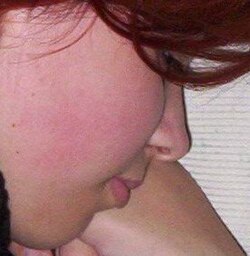Cheek
It has been suggested that High cheekbones be merged into this article. (Discuss) Proposed since September 2014. |
This article needs additional citations for verification. (January 2014) |
| Cheek | |
|---|---|
 Girl with prominent (puffy) cheeks. | |
| Details | |
| Artery | Buccal artery |
| Nerve | Buccal nerve, buccal branch of the facial nerve |
| Identifiers | |
| Latin | Bucca |
| MeSH | D002610 |
| TA98 | A01.1.00.008 A05.1.01.014 |
| TA2 | 116 |
| FMA | 46476 |
| Anatomical terminology | |
Cheeks (Latin: buccae) constitute the area of the face below the eyes and between the nose and the left or right ear. "Buccal" means relating to the cheek. In humans, the region is innervated by the buccal nerve. The area between the inside of the cheek and the teeth and gums is called the vestibule or buccal pouch or buccal cavity and forms part of the mouth. In other animals the cheeks may also be referred to as jowls.
Structure
Cheeks are fleshy in humans,[1] the skin being suspended by the chin and the jaws, and forming the lateral wall of the human mouth, visibly touching the cheekbone below the eye. The inside of the cheek is lined with a mucous membrane (buccal mucosa, part of the oral mucosa).
During mastication (chewing), the cheeks and tongue between them serve to keep the food between the teeth.
Other animals
The cheeks are covered externally by hairy skin, and internally by stratified squamous epithelium. This is mostly smooth, but may have aborally directed papillae (e.g.: ruminants). The mucosa is supplied with secretions from the Buccal glands, which are arranged in superior and inferior groups. In carnivores, the superior buccal gland is large and discrete: the Zygomatic gland. During mastication (chewing), the cheeks and tongue between them serve to keep the food between the teeth.
Some animals such as squirrels and hamsters use the buccal pouch to carry food or other items.
In some vertebrates, markings on the cheek area (malar stripes/spots/...), particularly immediately beneath the eye, often serve as important distinguishing features between species or individuals.
Buttocks
Sometimes people refer to the buttocks as the "cheeks", because of their round appearance.
Society and culture
The cheek is the most common location from which a DNA sample can be taken (during a cheek swab).
See also
- High cheekbones
- Blushing
- Cheek augmentation
- Erythema infectiosum
- Tongue-in-cheek
- Zygomatic bone
- Cheek kissing
- slap cheek
